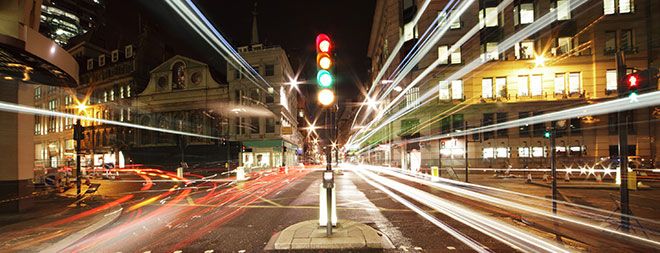Demystifying Driving's Dilemma Zone

(ISNS) -- It has happened to everyone: You are driving toward an intersection when the traffic light changes from green to yellow. Do you slam on the brakes and risk being rear-ended, or try to speed through the light and risk a collision or a traffic ticket?
The area around traffic lights where this decision must be made even has a scientific name, dilemma zone. The yellow light is supposed to warn you when the green light is about to change to red, but that just amplifies the dilemma. A group of scientists think they may have the answer: a warning before the warning.
The researchers, from a group of universities and the Federal Highway Administration, used simulators to test what they call intelligent advanced warning systems to see how drivers would react.
Just putting up a flashing light before a regular traffic light advising the green is about to change to yellow is an “unintelligent” warning, said Scott E. McIntyre, of Arizona State University Colleges at Lake Havasu City, one of the authors of the paper published in the journal Human Factors.
“The intelligent ones are designed for high-volume intersections,” said McIntyre, senior lecturer in the social and behavioral sciences.
“It is a predictive system,” he said. “The goal is to never put a driver in a situation where [the driver] is in a dilemma zone.”
In the simulation, these intelligent systems monitor the intersection, taking measure of where each vehicle is, what they are (car or tractor-trailer), and how fast they are moving. If it looks as if a driver is heading into the zone, the systems would give a warning before the light changes to yellow, he said.
Sign up for the Live Science daily newsletter now
Get the world’s most fascinating discoveries delivered straight to your inbox.
What the scientists wanted to see, is what the motorists would do then.
It’s a serious matter. In 2009, intersections hosted 1.2 million car collisions where 372,000 people were either killed or injured, a quarter of all automobile accidents involving death or injury. Matters may now be worse, scientists say, because as populations move away from cities, speeds at intersections have probably increased.
The researchers reported on two studies, both using simulators. They expressed their fears that motorists in simulators would not behave the way they would when actually driving, since there was no danger in a simulator, and they were being watched. But, they wrote the behavior of their subjects matched what scientists know about drivers and they were confident in their results.
In the first study, 98 participants recruited by Clemson University navigated through 36 high-speed intersections during a simulated 45-minute “drive.”
They tested three kinds of warnings. One was a single signal pole that flashed a warning before the green light would change; the second was a series of poles along the side of the road with lights that flashed in sequence toward the traffic light, something like the lights that guide planes landing at airports, and an onboard system that produced an LCD display on the dashboard and beeped just before a light change.
The question was, when given the warning, would the drivers slow down in anticipation of the change, speed up to race through the intersection, or just ignore the warning. In that study the warnings were aimed at all the cars in the dilemma zone.
In the second study, 83 participants at Clemson made use of warnings specific for each lane of the highway, including LEDs embedded in the highway itself, overhead bridges, or flashers along the right shoulder. The signals flashed warnings 1.5 seconds before the lights were to change.
They concluded that drivers who saw advanced warning rarely tried to run the light; most “exhibited greater anticipatory slowing well before the intersection.” They were more cautious. A very short warning, 1.5 to 3 seconds, was all that was needed to change behavior.
Warnings specific to lanes were somewhat better than the unspecific ones along the road at modifying unsafe behavior.
Why not simply extend the length of the yellow light? Tim Gates, associate professor of civil and environmental engineering at Wayne State University in Detroit, who was not involved in this research, said longer yellows would reduce the number of vehicles going through the intersection and have no impact on speed.
“Implementation will never be widespread,” Gates said of the extra warnings. “Some places have limited sight distances, high-speed approaches, and steep grades.”
And, that may not give the final answer. A graduate student at Oregon State University in Corvalis, who worked with David Hurwitz, an assistant professor of engineering, studied what happens when authorities put countdown clocks at intersections -- illegal here but common in other countries. The counters show how many seconds until the lights change, similar to what is sometime seen at crosswalks in the U.S.
The student, Mohammad Rabiul Islam, found that in countries that permit countdown clocks, many drivers speeded up to beat the clock. No one knows the reason for the difference in behavior, Hurwitz said.
Inside Science News Service is supported by the American Institute of Physics. Joel Shurkin is a freelance writer based in Baltimore. He is the author of nine books on science and the history of science, and has taught science journalism at Stanford University, UC Santa Cruz and the University of Alaska Fairbanks. He tweets at @shurkin.












